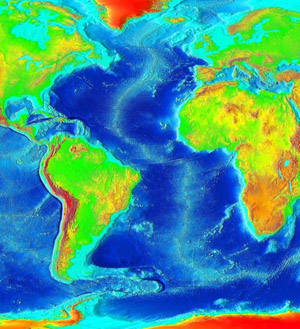Mixing of surface waters in the Atlantic Ocean seems to have reverted in the winter of 2007/2008 to normal levels for the first time in almost a decade, according to an analysis of the data published in Nature Geoscience.
One of the most worrying effects of climate change was that oceanic currents would be disrupted. With that disruption would come far-reaching changes to weather patterns and temperate northern zones plunged into a mini-ice age. At least that was the warning. Scientists have for the best part of a decade seen evidence that the mixing of surface waters to depths greater than 1 km in the northern North Atlantic Ocean may have been reduced to the levels at which currents might be retarded.

Atlantic bathymetry (Credit: U.S. National Oceanic and Atmospheric Administration)
Kjetil Våge and Robert Pickart of the Woods Hole Oceanographic Institution, Woods Hole, Massachusetts and colleagues in Canada, France, and the US, explain that over the last few years, deep mixing has been almost absent in the Labrador Sea and was linked to global warming. The researchers explain how this deep mixing is an essential part of the Atlantic Ocean circulation and as such is a key regulator of both carbon dioxide uptake by the oceans and heat transfer between the ocean and the atmosphere.
They have now used data from a network of measuring floats (from the Argo program) to detect the deep mixing of surface waters and evaluated local observations. The team also carried out computer simulations of past climate and mashed this with satellite data to help them understand the mechanisms that lead to this deep convection.
They conclude that it is a combination of air temperatures in the northern hemisphere, storm pathways, the flow of freshwater into the Labrador Sea and the distribution of pack ice that cools the ocean surface, and allows convection to mix surface waters to much greater depths than would otherwise occur. The complexity of this system suggests that modelling the convective system of the North Atlantic Ocean is no simple matter and that predicting outcomes given specific climate change parameters is going to be far more difficult than scientists hoped.
Kjetil Våge, Robert S. Pickart, Virginie Thierry, Gilles Reverdin, Craig M. Lee, Brian Petrie, Tom A. Agnew, Amy Wong, Mads H. Ribergaard (2008). Surprising return of deep convection to the subpolar North Atlantic Ocean in winter 2007–2008 Nature Geoscience DOI: 10.1038/ngeo382
Further reading
Kjetil Vaage profile
http://www.whoi.edu/profile.do?id=kjetil
Suggested searches
climate change
global warming
ocean currents